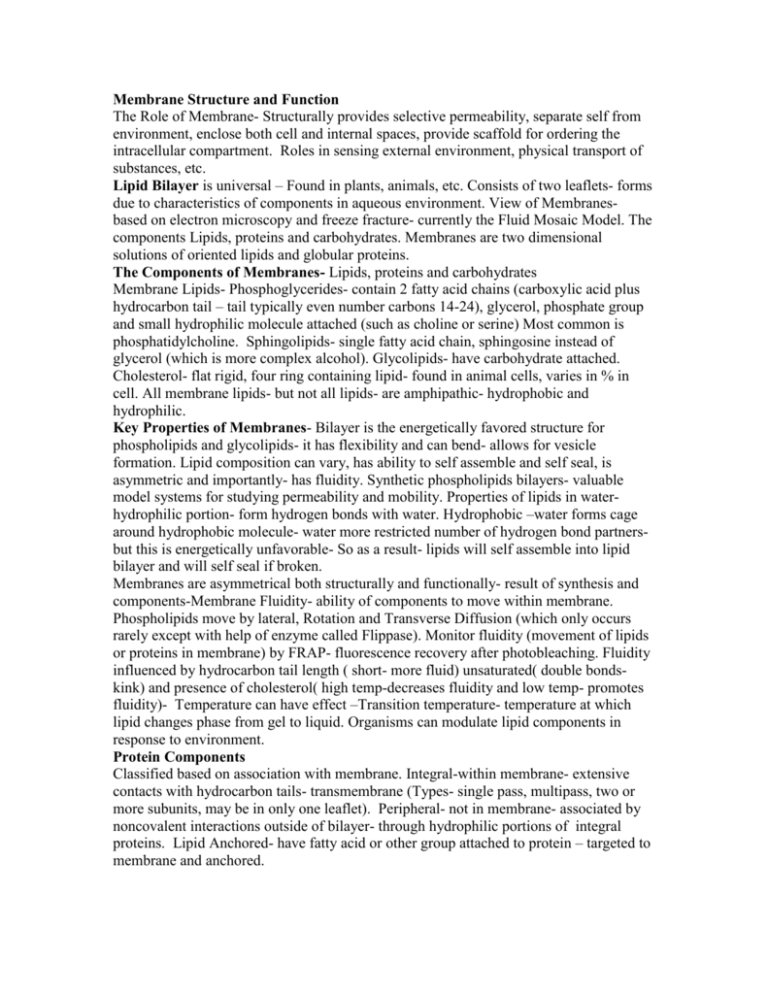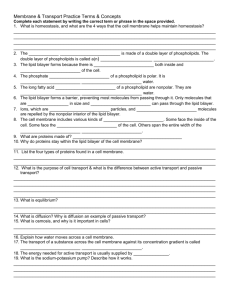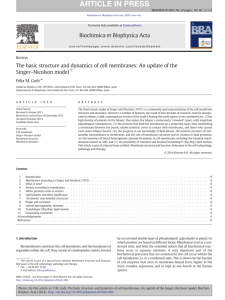Membrane Structure and Function
advertisement

Membrane Structure and Function The Role of Membrane- Structurally provides selective permeability, separate self from environment, enclose both cell and internal spaces, provide scaffold for ordering the intracellular compartment. Roles in sensing external environment, physical transport of substances, etc. Lipid Bilayer is universal – Found in plants, animals, etc. Consists of two leaflets- forms due to characteristics of components in aqueous environment. View of Membranesbased on electron microscopy and freeze fracture- currently the Fluid Mosaic Model. The components Lipids, proteins and carbohydrates. Membranes are two dimensional solutions of oriented lipids and globular proteins. The Components of Membranes- Lipids, proteins and carbohydrates Membrane Lipids- Phosphoglycerides- contain 2 fatty acid chains (carboxylic acid plus hydrocarbon tail – tail typically even number carbons 14-24), glycerol, phosphate group and small hydrophilic molecule attached (such as choline or serine) Most common is phosphatidylcholine. Sphingolipids- single fatty acid chain, sphingosine instead of glycerol (which is more complex alcohol). Glycolipids- have carbohydrate attached. Cholesterol- flat rigid, four ring containing lipid- found in animal cells, varies in % in cell. All membrane lipids- but not all lipids- are amphipathic- hydrophobic and hydrophilic. Key Properties of Membranes- Bilayer is the energetically favored structure for phospholipids and glycolipids- it has flexibility and can bend- allows for vesicle formation. Lipid composition can vary, has ability to self assemble and self seal, is asymmetric and importantly- has fluidity. Synthetic phospholipids bilayers- valuable model systems for studying permeability and mobility. Properties of lipids in waterhydrophilic portion- form hydrogen bonds with water. Hydrophobic –water forms cage around hydrophobic molecule- water more restricted number of hydrogen bond partnersbut this is energetically unfavorable- So as a result- lipids will self assemble into lipid bilayer and will self seal if broken. Membranes are asymmetrical both structurally and functionally- result of synthesis and components-Membrane Fluidity- ability of components to move within membrane. Phospholipids move by lateral, Rotation and Transverse Diffusion (which only occurs rarely except with help of enzyme called Flippase). Monitor fluidity (movement of lipids or proteins in membrane) by FRAP- fluorescence recovery after photobleaching. Fluidity influenced by hydrocarbon tail length ( short- more fluid) unsaturated( double bondskink) and presence of cholesterol( high temp-decreases fluidity and low temp- promotes fluidity)- Temperature can have effect –Transition temperature- temperature at which lipid changes phase from gel to liquid. Organisms can modulate lipid components in response to environment. Protein Components Classified based on association with membrane. Integral-within membrane- extensive contacts with hydrocarbon tails- transmembrane (Types- single pass, multipass, two or more subunits, may be in only one leaflet). Peripheral- not in membrane- associated by noncovalent interactions outside of bilayer- through hydrophilic portions of integral proteins. Lipid Anchored- have fatty acid or other group attached to protein – targeted to membrane and anchored. Transmembrane proteins transverse membrane as alpha helix- 20 amino acidshydrophobic - where polar backbone is not exposed. Multiple alpha helices can form bundle to create channel. Beta barrel is another structure formed to make channels/pores. Extraction of membrane proteins- Peripheral need just salt or pH change- Integral proteins usually require addition of detergent- disrupt protein-lipid interactions. Membrane proteins can be mobile-demonstrated by heterokaryon experiment of fusing human- mouse cells – show proteins of different membranes mix. Cells may required membrane proteins be limited in movement. Can occur through interactions with components of cytoskeleton, extracellular matrix, proteins on adjacent cells. Alternatively proteins can be restricted to specific sides of polarized cell through the presence of barriers within membrane. Glycocalyx- carbohydrate rich zone on outside of cell –important in protecting cells, prevent adherence to other cells, and move through tight passages. Facilitates cell- cell recognition. Contribute to Asymmetry of the membrane- sugars of glycolipids and glycoproteins are always facing the outside of plasma membrane.










